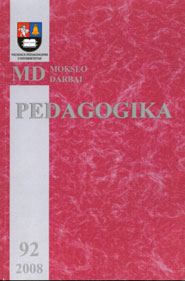Pradinio geometrinio lavinimo vaizdumo prioritetai: mokytojų nuomonė
Priority in Visualization of Primary Geometric Training: Teachers’ Opinion
Author(s): Vaiva GrabauskienėSubject(s): Education
Published by: Vytauto Didžiojo Universitetas
Keywords: geometric training; primary education; teaching principle; visualization.
Summary/Abstract: The present article provides the analysis of the problems on visualization in primary geometric training. The objective of the study is to characterise the manifestation of the principle of visualization by forming geometric images at primary school stages. First of all the author of this article discusses essential terminology used to describe visualization. The attempt was made to unify and supplement the terminology used by scholars of different countries. It was also attempted to classify types of visualization used by the above-mentioned scholars. The empirical study was focused on the answers to the following questions: • What are the attitudes of practical implementation of visualization in primary geometric training? • What visual aids in geometric training are primary school teachers apt to use? The analysis was based on the opinion provided by primary school teachers of urban and rural schools all over Lithuania. There were surveyed about 200 teachers in total. Methods of the research: analysis of theoretical literature, questionnaire-based inquiry, descriptive analysis of the data. Results of the research: The findings of the analysis show that in Lithuania primary school teachers follow the attitude of achieving visualization by different ways. In teaching geometry primary school teachers are mainly liable to make reference to material static or material dynamic means of visualization. Conditional-symbolic visualization in primary geometric training is used very seldom. In primary schools the attempt is being made to use the possibilities of geometric training provided by constructing activity. Unfortunately teachers feel short of methodical literature on this topic. Teachers make visual aids with the help of children or by themselves. They also try to find the aids in the surrounding environment. Other visual aids are used rarely
Journal: Pedagogika
- Issue Year: 2008
- Issue No: 92
- Page Range: 62-68
- Page Count: 7
- Language: Lithuanian

